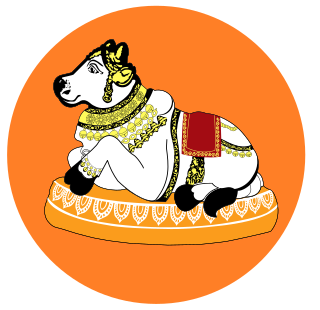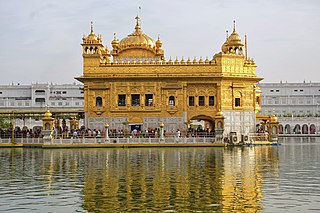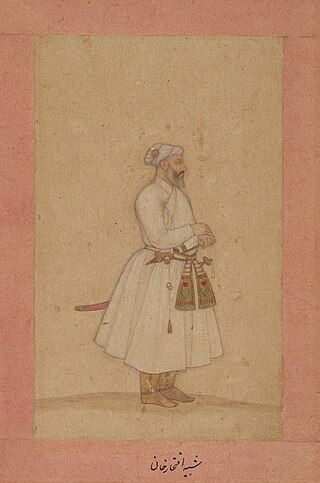Related Research Articles

Guru Tegh Bahadur was the ninth of ten gurus who founded the Sikh religion and was the leader of Sikhs from 1665 until his beheading in 1675. He was born in Amritsar, Punjab, India in 1621 and was the youngest son of Guru Hargobind, the sixth Sikh guru. Considered a principled and fearless warrior, he was a learned spiritual scholar and a poet whose 115 hymns are included in the Guru Granth Sahib, which is the main text of Sikhism.

Bhairava, or Kala Bhairava, is a Shaivite and Vajrayāna deity worshipped by Hindus and Buddhists. In Shaivism, he is a powerful manifestation, or avatar, of Shiva. In the tradition of Kashmir Shaivism, Bhairava represents the Supreme Reality, synonymous to Para Brahman. Generally in Hinduism, Bhairava is also called Dandapani, as he holds a rod or danda to punish sinners, and Svaśva, meaning, "he whose vehicle is a dog". In Vajrayana Buddhism, he is considered a fierce emanation of boddhisatva Mañjuśrī, and also called Heruka, Vajrabhairava, Mahākāla and Yamantaka.

The Kashmir Shaivism tradition, also called Trika Shaivism, is a non-dualist branch of Shaiva-Shakta Tantra Hinduism that originated in Kashmir after 850 CE. In its place of origin in Kashmir, this tradition is commonly referred to as "Kashmiri Shaivism." It later spread beyond Kashmir, with its great scholar Abhinavagupta calling it "Trika". It particularly flourished in the states of Odisha and Maharashtra. Defining features of the Trika tradition are its idealistic and monistic Pratyabhijna ("Recognition") philosophical system, propounded by Utpaladeva and Abhinavagupta, and the centrality of the three goddesses Parā, Parāparā, and Aparā.
Svātantrya is the Kashmiri Shaivite concept of divine sovereignty. Svātantrya is described as an energy that emanates from the Supreme (Paramaśiva), a wave of motion inside consciousness (spanda) that acts as the fundament of the world, or in another view, the original word. It does not use any external instrument as it itself is the first stage of creation.

Bhai Mani Singh was an 18th-century Sikh scholar and martyr. He was a childhood companion of Guru Gobind Singh and took the vows of Sikhism when the Guru inaugurated the Khalsa in March 1699. Soon after that, the Guru sent him to Amritsar to take charge of Harmandir Sahib, which had been without a custodian since 1696. He took control and steered the course of Sikh destiny at a critical stage in Sikh history. He was also a teacher of the Gianian Bunga, later becoming known as the "Amritsari Taksal", currently located in Sato Ki Gali.

Mohyal Brahmins are an Indian sub-caste of Saraswat Brahmins from the Punjab region. A sub-group of the Punjabi Hindu community, Mohyal caste comprises seven clans named Bali, Bhimwal, Chhibber, Datt, Lau, Mohan and Vaid.

Bhai Dayala, also known as Bhai Dayal Das, was an early martyr of Sikhism. He was boiled alongside his Sikh companions Bhai Mati Das and Bhai Sati Das and the Ninth Guru, Guru Tegh Bahadur.

Bhai Mati Das, along with his younger brother Bhai Sati Das were martyrs of early Sikh history. Bhai Mati Das, Bhai Dayala, and Bhai Sati Das were executed at a kotwali (police-station) in the Chandni Chowk area of Delhi, under the express orders of Emperor Aurangzeb just before the martyrdom of Guru Tegh Bahadur. Bhai Mati Das was executed by being bound between two pillars and cut in two.
Islam is an Abrahamic religion founded in the Arabian Peninsula, while Sikhism is an Indian religion founded in the Punjab region of the Indian subcontinent. Islam means 'submission to god'. The word Sikh is derived from a word meaning 'disciple', or one who learns.

Sardar Gurbachan Singh was a Sikh scholar, professor, and author. He was born in Moonak, Sangrur district. He was a lecturer at the Sikh National College at Lahore. At the Banaras Hindu University he held the Guru Nanak Chair of Sikh Studies. He received the Padma Bhushan in 1985. He received in 1985 the National fellowship by the Indian Council of Historical Research, New Delhi.

Indian Sikhs number approximately 21 million people and account for 1.7% of India's population as of 2011, forming the country's fourth-largest religious group. The majority of the nation's Sikhs live in the northern state of Punjab, which is the only Sikh-majority administrative division in the world.

Kaula, also known as Kula, and, is a Tantric tradition which is characterised by distinctive rituals and symbolism connected with the worship of Shakti and Shiva that is associated with cremation-ground or charnel ground sceticism, found in Shaktism and Shaivism.
Martyrdom is a fundamental institution of Sikhism. Sikh festivals are largely focused on the lives of the Sikh gurus and Sikh martyrs. Their martyrdoms are regarded as instructional ideals for Sikhs, and have greatly influenced Sikh culture and practices.

The Vijñāna-bhairava-tantra is a Shiva Tantra, of the Kaula Trika tradition of Kashmir Shaivism, possibly authored by Guru Keyūravatī. Singh notes that it is difficult to establish an exact date for the text, and it could have been written at some time from the 7th to the 8th century CE. It is also called the Śiva-jñāna-upaniṣad by Abhinavagupta.

Iftikhar Khan was the Mughal governor of the Subah of Kashmir from 1671 to 1675.

The Guru Granth Sahib, is the central religious text of Sikhism, considered by Sikhs to be the final sovereign Guru of the religion. It contains 1430 Angs, containing 5,894 hymns of 36 saint mystics which includes Sikh gurus, Bhagats, Bhatts and Gursikhs. It is notable among foundational religious scriptures for including hymns from writers of other religions, namely Hindus and Muslims. It also contains teachings of the Sikh gurus themselves.

Brahmin Sikh is a Sikh religious group whose members belong to Brahmin community. They played a key role in the early years of Sikhism. Sometimes they are called Kashmiri Sikhs, for those who are of Kashmiri origin.
SheikhBasharat Ullah (1801–1892), also known as Basahathullah or Basahatullah, was a Punjabi miniature painter who was employed as a court-painter for various states, such as Patiala State.
References
- ↑ "Pali: Language and Literature", Pali Buddhist Texts, Routledge, pp. 10–12, 2012-12-06, doi:10.4324/9780203061039-5, ISBN 978-0-203-06103-9 , retrieved 2024-02-21
- ↑ Rhys Davids & Stede (1921–1925). "entry for "Viññāṇa"". The University of Chicago's "Digital Dictionaries of South Asia": 618 – via University of Chicago.
- ↑ "Screenshot of Itunes Library - Archived Platform Itunes 2010". doi:10.3998/mpub.11435021.cmp.6 . Retrieved 2024-02-21.
{{cite journal}}: Cite journal requires|journal=(help) - ↑ Radhakrishnan, Sarvepalli, ed. (2003). The principal Upaniṣads (11. impr ed.). New Delhi: HarperCollins Publ. India. ISBN 978-81-7223-124-8.
- ↑ Bennet, Alex; Bennet, David (2008-04-11). "Moving from knowledge to wisdom, from ordinary consciousness to extraordinary consciousness". VINE. 38 (1): 7–15. doi:10.1108/03055720810870842. ISSN 0305-5728.
- ↑ "Sri Chinmoy Library". www.srichinmoylibrary.com. Retrieved 2024-02-21.
- ↑ Liangkang, Ni (2010), "The Ultimate Consciousness and Alaya-vijnana: A Comparative Study on Deep-Structure of Consciousness between Yogacara Buddhism and Phenomenology", Phenomenology 2010. Volume 1, Selected Essays from Asia and Pacific, Zeta Books, pp. 81–112, doi:10.7761/9789731997643_4, ISBN 978-973-1997-63-6 , retrieved 2024-02-21
- ↑ Allon, Mark (October 1997). "South Asia - Sue Hamilton: Identity and experience: the constitution of the human being according to early Buddhism. xxxi, 218 pp. London: Luzac Oriental, 1996. £30". Bulletin of the School of Oriental and African Studies. 60 (3): 571–573. doi:10.1017/s0041977x00032833. ISSN 0041-977X. S2CID 162873646.
- ↑ Bodhi, Bhikkhu (2000). The connected discourses of the Buddha: a translation of the Samyutta Nikāya. The teachings of the Buddha. Boston (Mass.): Wisdom. ISBN 978-0-86171-331-8.
- ↑ Sun, H; Zhao, Y; Chen, M; Jin, W (2018-02-15). "Abstract P1-03-09: Not presented". Cancer Research. 78 (4_Supplement): P1–03-09-P1-03-09. doi:10.1158/1538-7445.sabcs17-p1-03-09. ISSN 0008-5472.
- ↑ "Shiva, The Masculine Principle In Tantra – SivaSakti" . Retrieved 2024-02-21.
- ↑ Lawrence, David Peter (2017-11-22), Bilimoria, Purushottama (ed.), "Tantra and Kashmiri Śaivism", History of Indian Philosophy, Routledge, pp. 408–417, doi:10.4324/9781315666792, hdl: 10536/DRO/DU:30113046 , ISBN 978-1-315-66679-2
- ↑ Goodall, Dominic (2023-01-26), "Śaiva Tantra", The Oxford Handbook of Tantric Studies, Oxford University Press, pp. 1035–1056, doi:10.1093/oxfordhb/9780197549889.013.45, ISBN 978-0-19-754988-9 , retrieved 2024-02-21
- ↑ Hayes, Glen A., "The Necklace of Immortality", Tantra in Practice, Princeton University Press, pp. 308–325, doi:10.2307/j.ctv3hh53v.26 , retrieved 2024-02-21
- ↑ "Third Udasi - SikhiWiki, free Sikh encyclopedia". www.sikhiwiki.org. Retrieved 2024-02-21.
- ↑ Singh, Komal J. B. (2020-11-28), "The 1947 Massacre and Its Impact on Sikhs in Kashmir", Society and Politics of Jammu and Kashmir, Cham: Springer International Publishing, pp. 281–297, doi:10.1007/978-3-030-56481-0_14, ISBN 978-3-030-56480-3, S2CID 229411274 , retrieved 2024-02-21
- 1 2 Singh, Kashmir (2013-10-01). "Shiromani Gurdwara Parbandhak Committee". Oxford Handbooks Online. doi:10.1093/oxfordhb/9780199699308.013.039.
- 1 2 Grewal, J. S. (2003). The Sikhs of the Punjab. The new Cambridge history of India / general ed. Gordon Johnson 2, Indian States and the transition to colonialism (Rev. ed., transferred to digital print ed.). Cambridge: Cambridge Univ. Press. ISBN 978-0-521-63764-0.
- ↑ Dhavan, Purnima (2011-11-02). When Sparrows Became Hawks: The Making of the Sikh Warrior Tradition, 1699-1799. Oxford University Press. ISBN 978-0-19-987717-1.
- ↑ Singh, Pashaura; Fenech, Louis E. (March 2014). The Oxford Handbook of Sikh Studies. OUP Oxford. ISBN 9780199699308.
- ↑ "The Supreme Sacrifice of Guru Tegh Bahadur - The Hindu Religion seeks Protection". www.sikhmissionarysociety.org. Retrieved 2024-02-21.